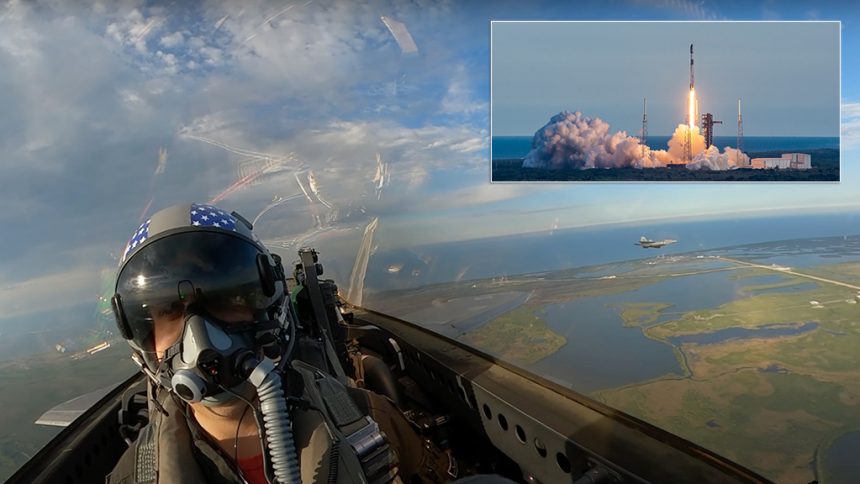Experience the thrill of a SpaceX Falcon 9 launch from the cockpit of an F-22 soaring over NASA’s Kennedy Space Center and the iconic Vehicle Assembly Building.
On Apr. 18, 2024, SpaceX successfully launched the Starlink Group 6-52 mission from Cape Canaveral Space Force Station, Florida. This mission involved deploying 23 Starlink v2-mini satellites into low Earth orbit, enhancing SpaceX’s second-generation high-speed internet satellite constellation.
The launch utilized a Falcon 9 Block 5 rocket, marking its 326th mission and the 40th SpaceX mission of 2024. The booster, designated B1080, achieved its 7th flight and 297th successful recovery, underscoring yet another success in reusable rocket technology.
Falcon 9 launches 23 @Starlink satellites to low-Earth orbit from Florida pic.twitter.com/v3SiSoZKbp
— SpaceX (@SpaceX) April 19, 2024
The video in this post was shot on that day, during the launch of the SpaceX Falcon 9 rocket for the Starlink mission 6-52 from Space Launch Complex 40 at Cape Canaveral Space Force Station, Florida.
The video opens with a view from the cockpit of an F-22 Raptor. The camera angle provides a clear view of the landscape below, the coastal region of Florida near Kennedy Space Center. At 00:56, as the rocket ignites and lifts off, the F-22s are seen flying in a protective pattern around the launch area.
As the rocket climbed, the two F-22 Raptors escorted the Falcon 9 going vertical in full afterburner up to an altitude of 18,000 feet, providing a breathtaking and unique aerial perspective. After reaching this altitude, the two 5th generation stealth jets veered off and flew west towards the 2024 Orlando Air Show.
The footage of the F-22s chasing the Falcon 9 rocket up to Class A Airspace was shot from Captain Samuel “RaZZ” Larson’s cockpit, alongside Safety Officer Sawyer Murray in exclusive for Air Dot Show Tour Youtube channel.
Enforcing NFZs Over Kennedy Space Center
At this point, it’s worth highlighting that Cape Canaveral Space Force Station (CCSFS) and Kennedy Space Center (KSC) are two distinct facilities located next to each other.
Cape Canaveral is an Air Force Base, owned and operated by the Air Force, known for its history of rocket launches. Over the years, there have been around two dozen launch complexes at Cape Canaveral, though most are now inactive and in disrepair. Currently, there are three active launch complexes at Cape Canaveral: Complex 37 for the Delta 4, Complex 40 for SpaceX (formerly used for the Titan 3), and Complex 41 for the Atlas 5 (also a former Titan 3 pad).
Kennedy Space Center, is instead owned and operated by NASA. It was established on an 87,000-acre parcel of land purchased by NASA around 1962 to support the Apollo program. KSC features two launch pads, Pads 39A and 39B, which were initially used for the Saturn V launches during Apollo and were later modified for Space Shuttle launches.
The airspace used by space vehicles launched from either Cape Canaveral or KSC is controlled by the U.S. Air Force. This means that regardless of whether a launch occurs from Cape Canaveral or KSC, the Air Force must approve the launch.
During rocket launches at NASA’s Kennedy Space Center or Cape Canaveral Space Force Station (CCSFS), the airspace is strictly controlled and designated as a No-Fly Zone (NFZ) to ensure safety. F-22 Raptors and other combat aircraft may be deployed to patrol this airspace and intercept any unauthorized aircraft.
SpaceX Falcon 9
The Falcon 9 is a versatile, partially reusable medium-lift launch vehicle designed, manufactured, and launched by the American aerospace company SpaceX. It is capable of carrying both cargo and crew into Earth orbit and can also function as an expendable heavy-lift launch vehicle. The inaugural launch of the Falcon 9 took place on June 4, 2010, and its first commercial resupply mission to the International Space Station (ISS) occurred on October 8, 2012. In 2020, the Falcon 9 became the first commercial rocket to launch humans into orbit and remains the only U.S. rocket certified for human transport to the ISS. By 2022, it set records as the U.S. rocket with the most launches and the best safety record, with only one flight failure.
The Falcon 9 comprises two stages. The first stage, or booster, carries the second stage and payload to a specific speed and altitude. Then, the second stage propels the payload to its designated orbit. The booster is designed to land vertically, allowing for reuse. This capability was first demonstrated on the rocket’s 20th flight in December 2015. As of June 8, 2024, SpaceX has successfully landed Falcon 9 boosters 303 times, with individual boosters having flown up to 21 missions. Both stages are powered by SpaceX Merlin engines, which use cryogenic liquid oxygen and rocket-grade kerosene (RP-1) as propellants.
Watch Falcon 9 launch 23 @Starlink satellites to orbit https://t.co/h5OLKuqLuH
— SpaceX (@SpaceX) April 18, 2024
The heaviest payloads the Falcon 9 has delivered to geostationary transfer orbit (GTO) include Intelsat 35e, weighing 6,761 kg (14,905 lb), and Telstar 19V, weighing 7,075 kg (15,598 lb). The former was launched into a super-synchronous transfer orbit, while the latter was placed into a lower-energy GTO. On Jan. 24, 2021, Falcon 9 set a record by launching 143 satellites into orbit on a single mission.
The Falcon 9 is certified to transport NASA astronauts to the ISS and is approved for the National Security Space Launch program and NASA’s Launch Services Program as “Category 3,” capable of handling the most expensive and complex NASA missions. Several iterations of the Falcon 9 have been developed: v1.0 (2010-2013), v1.1 (2013-2016), and v1.2 Full Thrust, which first launched in 2015 and includes the Block 5 variant in operation since May 2018.









